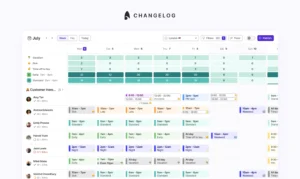
How can Surfboard help with effective real time management in call centres?

Customer loyalty has become volatile and is changing with each interaction. Today’s customers no longer want just good service; they crave outstanding, personalised experiences. They want solutions to their problems in real time and expect businesses to meet and predict their needs.
This shift in consumer behaviour demands that firms stay ahead of their customers, which is where real time management becomes crucial.
In this blog post, we’ll delve into what call centre real time management is, its pros, and what tools you can use for effective real time management.
Let’s start with the basics.
What is real time management?
Real time management is monitoring your support teams’ current, up-to-the-minute activities. It involves actively overseeing and responding to ongoing activities at the call centre as they happen, without any delays. In simpler terms, it’s like being on your toes.
Real time management may include monitoring the following:
- call volume,
- agent availability & performance,
- customer wait times, and
- service levels to make adjustments on the fly.
For example, if call volume suddenly spikes due to a marketing campaign, real time management allows managers to reassign surfers to handle the increased workload. This helps reduce long customer wait times and ensure service levels are met.
But do you really need call centre real time management? Let’s explore.
Do you need real time management in call centres?
Customers wait hours for a response, agents struggle to keep up, opportunities slip through the cracks, and, most importantly, your company image deteriorates due to customer dissatisfaction. This is the opportunity cost of not enforcing real time management in your call centre. This further leads to more significant problems adversely impacting your business in the following ways:
- Long hold times for callers lead to frustration.
- Call centres may struggle to distribute staff optimally.
- Agents miss opportunities to resolve customer issues promptly and other upsell/cross-sell opportunities.
- Without real time monitoring, it’s hard to identify and address agent performance issues.
- KPIs and metrics may not reflect the actual state as they may be based on outdated data.
- Customers not receiving timely help may take their business elsewhere, leading to customer churn.
In short, real time management has become paramount to keeping your call centre thriving. Without real-time management, you’re like an outsider looking in who can’t understand the real picture and adapt to the constantly changing landscape.
Now, let’s explore the benefits ofreal time management in call centres.
Upsides of call centre real time management
Here are five primary advantages of real time management.
Improved customer satisfaction
Real time management allows call centres to address customer issues promptly and improve the CSAT scores. Since 90% of customers view an instant response as either crucial or very important in customer service assistance, your surfers need access to up-to-the-minute information to help them resolve problems quickly.
Also, real-time data provides valuable insights into customer preferences and behaviour, allowing for more personalised interactions and a better business roadmap.
Cost savings
By optimally allocating resources, call centres can ensure they have the right number of surfers available at any given time to handle incoming call volume efficiently. This prevents overstaffing during periods of low inbound queries and understaffing during peaks, reducing labour costs.
💡Pro-tip: Use an Erlang calculator to calculate the number of staff you need beforehand to ensure seamless workforce planning.
Moreover, real-time monitoring can assist you in identifying areas for process improvement, expedite decision-making and implement cost-effective strategies promptly.
Higher agent productivity
A whopping 59% of the agents are at risk of burnout. Real time management helps you assign tasks based on real-time data. You can track what surfers are working on and balance out the workloads. This, in turn, improves employee morale, reduces stress, and lowers turnover rates.
Implement the best workforce management software, Surfboard that simplifies workforce scheduling and shift management for your support teams with its intraday scheduling feature.
With Surfboard, you can also track your surfer’s behavioural trends and identify those requiring additional training or resources to perform better. Further, gain insights into individual and team performance with Surfboard’s time-on-task feature and help surfers boost their productivity through training.
Better task prioritisation and risk mitigation
Real-time data and analytics assist supervisors in prioritising tasks effectively. They can allocate resources where they are needed most and mitigate potential risks or issues as they arise. This proactive approach helps lower customer churn rates and maintain a consistent level of service quality.
Now that we have understood the benefits of real-time customer experience management, let’s delve into the tools that can help you.
Tools for real-time customer experience management
Many companies fall into the trap of being purely reactive when it comes to real-time customer service management. In this approach, they wait for customer issues to arise before taking action. For example, if a customer reports a problem with a product or service, they rush to address it.
While this approach is essential for resolving issues as they occur, it often means playing catch-up and firefighting, leading to frustrated customers and burnt-out employees.
On the other hand, a proactive approach in real time management involves anticipating and mitigating issues before they become major problems. Companies using this approach can,
- actively monitor customer interactions,
- track performance metrics, and
- analyse data to identify potential pain points and trends.
They use this information to formulate strategies and adjust their operations in real time to prevent problems from arising in the first place.
Here are a few tools and solutions companies use to adopt a proactive real time management approach.
Scheduling software
Employee shift scheduling software offers a centralised platform for customer support teams to plan and schedule shifts. It primarily streamlines employee activities and ensures operational efficiency.
Surfboard is a scheduling platform with advanced features to manage your call centre workforce in the best possible way. Here are a few of them:
- Monitor your entire customer support function using the real-time dashboard. Quickly respond to unexpected peaks in customer queries or service requests. Easily redeploy additional capacity to high-priority channels or specific tasks.
- Intuitive shift planning allows building shift plans and patterns from scratch based on your team’s unique needs. It automatically assigns shifts weeks in advance.
- Create custom shift patterns and plans for all your team’s needs, including rotations and round robins. Build shift patterns based on your needs – a shift plan for a specific campaign, one for sales, another for Christmas, and so on.
- Build custom accurate forecasts and use filters to group your tickets to reflect your customer channels or how your team is structured. Use your historical ticket data to predict inflow and understand how many surfers you need.
- Automate scheduling across days, weeks, and months by giving Surfboard your scheduling rules and priorities.
- Get real-time insights into surfer performance with intraday scheduling and time-on-task features.
- Manage global shifts across countries. Quickly view schedules across timezones in a single dashboard and easily schedule channels in multiple languages using surfer skills.
Overall, Surfboard helps you make informed and prompt decisions with real-time insights into call volumes, surfer availability, and performance metrics. Also, you can integrate Surfboard with your existing tool stack to operate seamlessly.
Live chat and messaging apps
With Gen-Z taking command of buying decisions now, 42% of customers prefer live chat, making it a crucial tool for call centre real time management.
With live chat and messaging apps, customers can reach out to a business and get real-time responses. Further, customers can know whom they connect with and when the rep types a response.
Moreover, integrating AI-powered chatbots into these apps further adds to the real-time handling of routine queries 24/7, freeing human agents for more complex issues.
Analytics and reporting tools
Real-time customer experience management heavily relies on data-driven insights. Analytics and reporting tools allow companies to monitor customer conversations as they happen. These tools gather data from various touchpoints, such as websites, mobile apps, and social media, and provide real-time dashboards and reports.
By analysing this data in real time, businesses can identify emerging consumer trends, track customer sentiment, and assess the effectiveness of their customer service efforts.
Automation tools
Automation plays a fundamental role in call centre real time management. Automation tools enable businesses to streamline and expedite repetitive processes to deploy consistent responses to actions that may arise.
By automating routine tasks, companies save time, reduce the risk of errors and mitigate potential risks, ensuring a smoother & more responsive customer experience. For example, Surfboard automates scheduling. Once you feed your rules and priorities, it can automatically create schedules across months.
Put your growth on fast-forward with real time management
Real time management has the ability to recharge your CX engine. As your service team takes the lead in driving growth, it is important to monitor in real time whether they are sticking to the schedules or not.
While the industry-recommended schedule adherence rate for agents is 85% or higher, Surfboard’s time-on-task feature can help you track surfers’ schedule adherence.
Further, Surfboard’s round-robin scheduling ensures a balanced workload for your surfers, and the forecasts enable you to ensure that there are enough people for each job.
Want to see Surfboard in action?
Check out how Mercuryo, a payments platform, achieved a 90%+ service level using Surfboard’s activity scheduling.
To learn more, schedule a demo now.
FAQs
Q: What are 4 types of real time management?
Four common types of real time management are workforce management, quality monitoring, performance analytics, and skill-based routing.
Q: What is an example of real time management?
An example of real time management is a call centre supervisor reallocating agents to address a sudden increase in call volume during a marketing campaign.
Q: How does real time management benefit customer service teams?
A: Real time management benefits customer service teams by enabling them to allocate resources efficiently, reduce customer wait times, improve agent performance, and enhance overall service quality.
Q: Are there any challenges associated with implementing real time call centre management?
Yes, challenges can include the need for specialised software and training, ensuring data accuracy, and balancing real-time decisions with long-term strategic goals.
Q: What tools are commonly used in real time management for customer service?
Common tools include contact centre solutions (with real-time queue management feature), workforce management software, quality monitoring systems, real-time dashboards, support team scheduling software, performance analytics tools, and skill-based routing systems.



